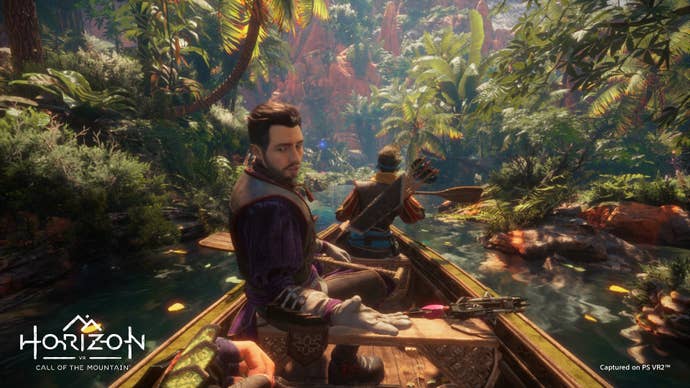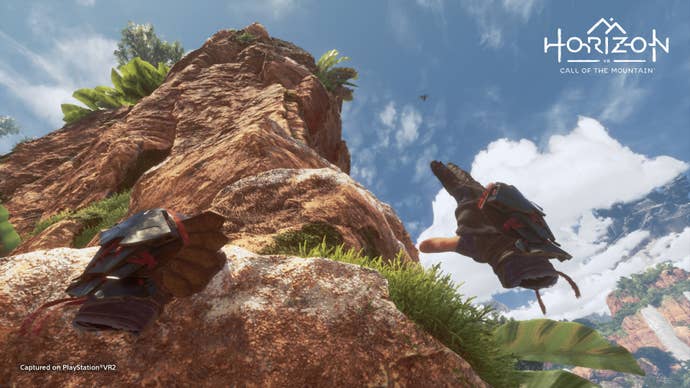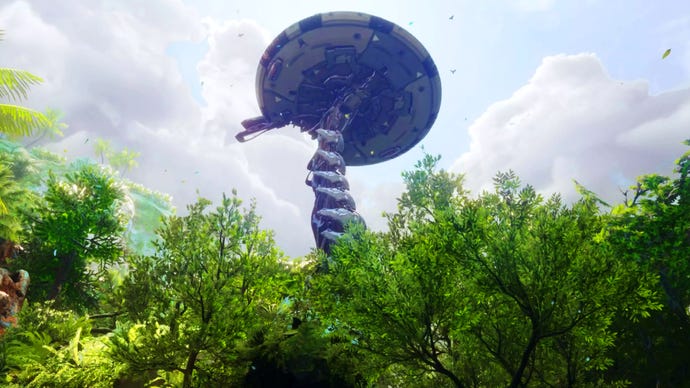Horizon Call of the Mountain review: The view is worth the climb
PS VR2’s key launch title is gorgeous, but at times a little dull.
I know people seem to want fully interactive experiences in VR, like “proper” games, but there’s something to be said for more passive moments. Horizon Call of the Mountain is PlayStation VR2’s headline game, built especially for the new headset and controllers. It offers a full experience – it's more streamlined than the core Horizon games, but it’s one of those “proper” games. But, and maybe I’ll be in the minority here, I prefer it when it’s just letting me take in the spectacle and not making me do too much. My arms can’t take much more climbing!
Call of the Mountain opens with one of the most incredible set-pieces I’ve ever seen. But in VR you’re doing more than seeing it, at least in how it’d work in a traditional on-TV video game. You’re there. In this instance, on a rowboat, helpless as you come under attack from the machines. These mechanical monsters are all around you, over you, coming for you. You’re only along for the ride at this point, but I’d have sat through an entire game like this. It is incredible.
After this breathtaking moment (well, I at least found myself holding my breath at points) the game begins and puts you in full direct control of Ryas. What follows is a fairly linear journey through a beautiful land (that you can explore freely within its boundaries), with plenty of bow and arrow shooting, a lot of climbing, and arena-style battles against machines. Some of these elements work better than others. Did I mention that there is a lot of climbing?

Climbing is the weakest core gameplay beat, which is a bit disappointing given that the whole game is based on a mountain – a mountain that must be climbed and has multiple structures on it to climb. It’s functional, you moving your controllers as hands to pull yourself up and across multiple marked paths, but I couldn’t get my brain to connect with it. These sequences feel like you are moving the mountain itself rather than Ryas and the result is a sense that the mountain is floating weightlessly in the world rather than being a hulking great landmass. You can’t see your own body, either, so it’s easy to disconnect from the whole thing rather than look down and have your stomach turn at the expanse of nothingness beneath you.
Exploration is handled either by classic FPS controls or a more motion-sickness-friendly teleportation system, and it’s pretty neat (and while I’m here, the game plays well either sat down or stood up, which is nice). There are plenty of items in the world to interact with (I was fond of bashing a tambourine early on in the game) and hidden objects to find. There’s something irresistible about a table full of crockery that you can smash up or fling like frisbees into the distance, and this kind of world interaction crops up all over the 7-ish hour experience – although I do wonder how long I spent throwing snowballs and doing other trivial activities that padded that out a little.
Oh, and did I mention how astonishingly gorgeous this game is? Aside from the bow and arrow (which I’ll get to in a moment), the world itself and how you feel like you can truly see all of it, is the star of the show. To be rather archaic, Horizon Call of the Mountain is proper demo disc material – and there’s a neat unlockable mode that serves this purpose very well. Plenty of options are available to tweak your comfort in VR, too, so if you struggle a bit with movement you can add a vignette around the screen, that kind of thing.

The bow and arrow, then, the game’s weapon, is superb in VR. It feels so natural I’m not sure the tutorial to explain it was even needed, and aiming inside the world is spot-on. Whether or not there’s a heavy dose of target-lock going on behind the scenes or not, snapping off a shot to hit your target right in the sweet spot never gets old. You'll gain access to multiple other tools on your journey, but it’s this core weapon that stands out.
Combat is largely restricted to arena battles against one large or multiple smaller machines, where not only is the area restricted but your movement is also limited to strafing and dashing. I think this was a sensible choice for the average VR user – especially anyone completely new to it – but at points throughout the adventure you can take on machines with completely free movement, which works pretty well and may leave some more hardcore users wishing there was more like it.
If there’s a real weakness to Horizon Call of the Mountain it’s the frequent talks with NPCs. While these look brilliant, the characters seemingly looking right at you in the eyes (presumably down to the VR2 headset’s eye tracking tech), I found them pretty dull. I have played both Horizon games to date, but I didn’t adore them like some people do, so all the lore fell on deaf ears. I get that these characters don’t like Ryas, at all, but that’s pretty much all I took on board from all the conversations. If you’re completely new to Horizon it might be akin to jumping into the middle of an Adrian Tchaikovsky novel – a bit hard to understand.

I’m sure you’ve glanced at the review score below and made a judgement on Horizon Call of the Mountain, but despite that score I still think all PSVR2 owners should pick this up. It’s undoubtedly the most spectacular VR game I’ve ever played, it’s got plenty of cool gameplay moments that show off the controllers, and it’s a full-on game to play through, but it’s also a bit tedious at times, and boring at others.











